
MUSEUM ART COLLECTION Ottoman Room from the Ethnological Collection of the National Museum in Sarajevo
May 29, 2020 FEATURE, Art Collection

Islamic art has always integrated various forms of crafts. For example, the furniture inside mosques, tekkes, palaces, and houses was made in metal, porcelain, and wood, and decorated by carpet weaving, calligraphy, etc. The main focus in mosques was to decorate mihrabs, mimbers, mahvils, and walls, in connection to carpets or rugs. All of them were made of stone, except mimbar and mahvil, which were made of wood. Also, mosque lamps were always beautifully crafted and decorated.
In houses, next to carpets and rugs, all furniture was decorated, mostly sofas and room closets. Also, most families used metal and ceramic dishes that were beautifully decorated. The ceilings were specially decorated, which gave the interior a focal point. Several rooms, or more precisely, home interiors, have been preserved, in Islamic museum collections, across the globe. The rooms belonged to families that filled their living space with art and richly decorated items. This mentality was common in Islamic countries and was accepted also by less affluent families. Houses were clean since the whole interior was treated as a place of prayer, and as such, it was protected and decorated. The masjid inside the house was separated from the living space, and in cases, when there was not a special prayer room, the occupants were able to perform the prayer in any of the rooms. An Islamic house was divided into private and public parts, private for family life, and public for receiving guests. Nowadays, relatively few original interiors of Islamic houses, older than a hundred years, have been preserved. The preserved rooms are true works of art, and as such, they have been transferred to museums and saved from decay.
Syrian rooms, or rooms from the cities of Damascus and Aleppo, are especially famous. The most famous are the Aleppo room from the 17th century at the Museum of Islamic Art in Berlin, the Damask rooms from the Metropolitan Museum in New York, and the Islamic Art Museum Malaysia in Kuala Lumpur. They are interesting not only because of the extraordinary decoration and painted woodwork but also because they are a mixture of different influences since they represent Ottoman rooms of the Arab type. This complexity of influence is difficult to explain in brief, but we can speak of the intertwining of Arab, Turkish, and Iranian elements of decoration within the Ottoman civilization framework.
A special group of Ottoman rooms is in today's Turkey and the Balkans, which are very similar, with no special difference between them, in terms of culture, style, or understanding of the aesthetics by their inhabitants. The best known are those inside the Topkapi Palace, or so-called Jalia on the shores of the Bosphorus. Also, in Turkey, some caravanserais have been preserved, with extraordinary wooden details and painted walls.
In the Balkans, the best-preserved examples are Bosnia and Herzegovina, which was part of the Ottoman Empire for about 500 years. Several representative houses, with rich interiors, have been preserved in Sarajevo and Mostar. One such example is the Ottoman room in the National Museum, in Sarajevo. It represents a high degree of culture of living within the Bosnian urban population. This interior dating from the beginning of the 18th to the 19th century belonged to a family that was located in the old Sarajevo neighbourhood Nadkovaci. The entire room was transferred to the museum premises for preservation. What makes this room interesting are the decorations that fully cover the surface of wooden furniture, the walls, and the windows.
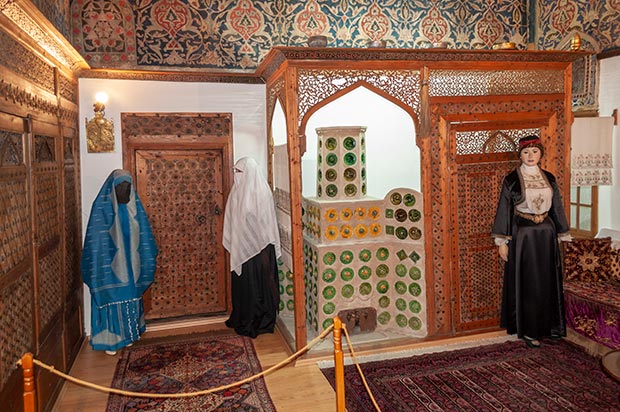 Interior of the Ottoman room at the National Museum Sarajevo. Photo © Islamic Arts Magazine
Interior of the Ottoman room at the National Museum Sarajevo. Photo © Islamic Arts Magazine
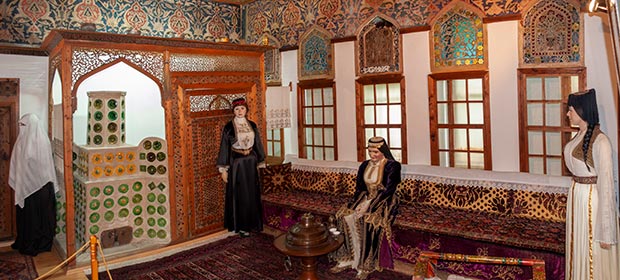 Interior of the Ottoman room at the National Museum Sarajevo. Photo © Islamic Arts Magazine
Interior of the Ottoman room at the National Museum Sarajevo. Photo © Islamic Arts Magazine
The ceiling of this room is especially interesting, as it has an octagonal wooden lamp housing in the middle. This lamp case, also a decorative element, is painted with intertwined multicoloured curly elements. The entire ceiling is intersected by long wooden planks that form a decorative element of the so-called David's star or David's seal, as it is understood in Islamic culture. The interior of the star is painted blue, and the points are in ocher colour.
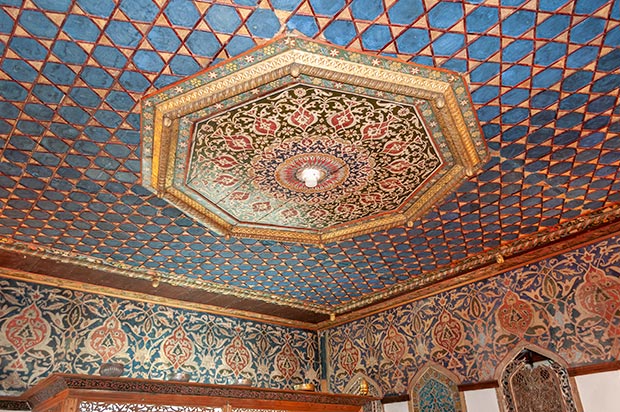 Interior of the Ottoman room at the National Museum Sarajevo. Detail of the ceiling. Photo © Islamic Arts Magazine
Interior of the Ottoman room at the National Museum Sarajevo. Detail of the ceiling. Photo © Islamic Arts Magazine
The upper zones of the walls have floral-painted medallions with intertwined twigs, in the form of ribbons and friezes. The background is blue, with the medallions painted in red and ocher colour. The windows are exquisitely decorated with coloured stained glass and the walls are mostly covered with wooden carved furniture and a large ceramic stove in the corner of the room. Along the walls is a richly decorated sofa with handmade blankets and carpets. The room includes female manikins dressed in the rich fashion of that time.
 Interior of the Ottoman room at the National Museum Sarajevo. Detail of the wall decoration. Photo © Islamic Arts Magazine
Interior of the Ottoman room at the National Museum Sarajevo. Detail of the wall decoration. Photo © Islamic Arts Magazine
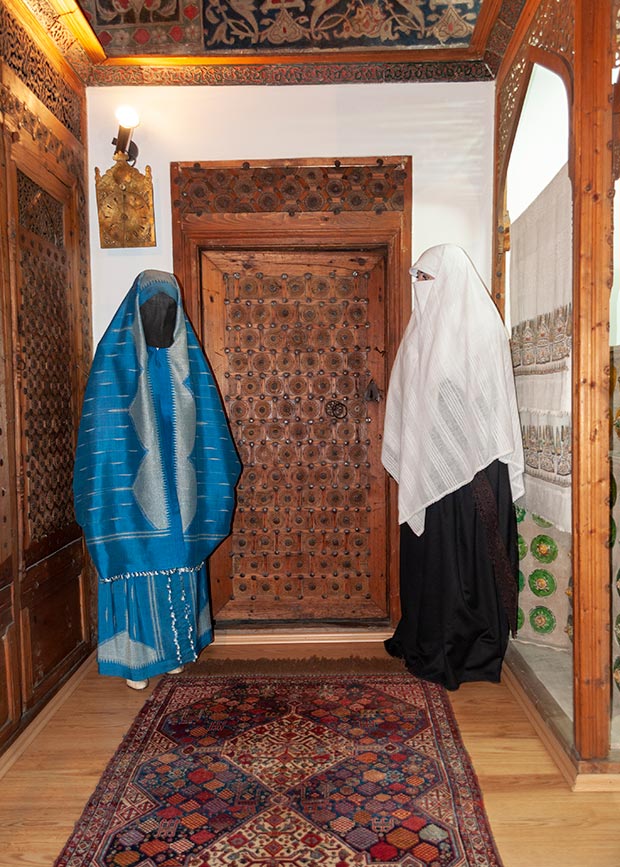 Interior of the Ottoman room at the National Museum Sarajevo. Manikins dressed it to the dress code of that era. Photo © Islamic Arts Magazine
Interior of the Ottoman room at the National Museum Sarajevo. Manikins dressed it to the dress code of that era. Photo © Islamic Arts Magazine
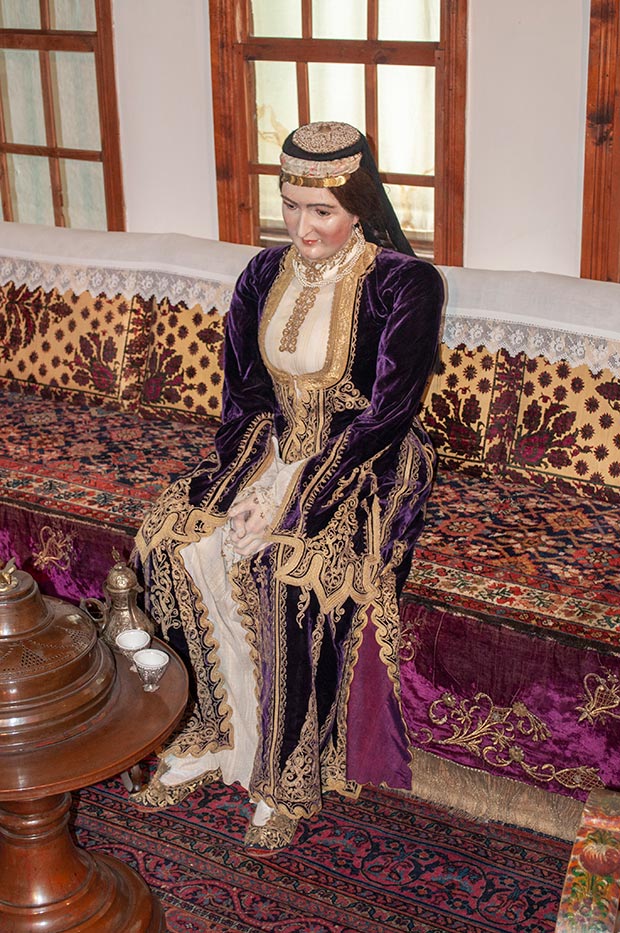 Interior of the Ottoman room at the National Museum Sarajevo. Manikins dressed it to the dress code of that era. Photo © Islamic Arts Magazine
Interior of the Ottoman room at the National Museum Sarajevo. Manikins dressed it to the dress code of that era. Photo © Islamic Arts Magazine
This interior belonged to the Bosnian nobility from the Ottoman time. Due to its decorative elements and preservation, it is one of the most beautiful rooms in the Islamic world, when it comes to family homes.
Comments
Add a comment